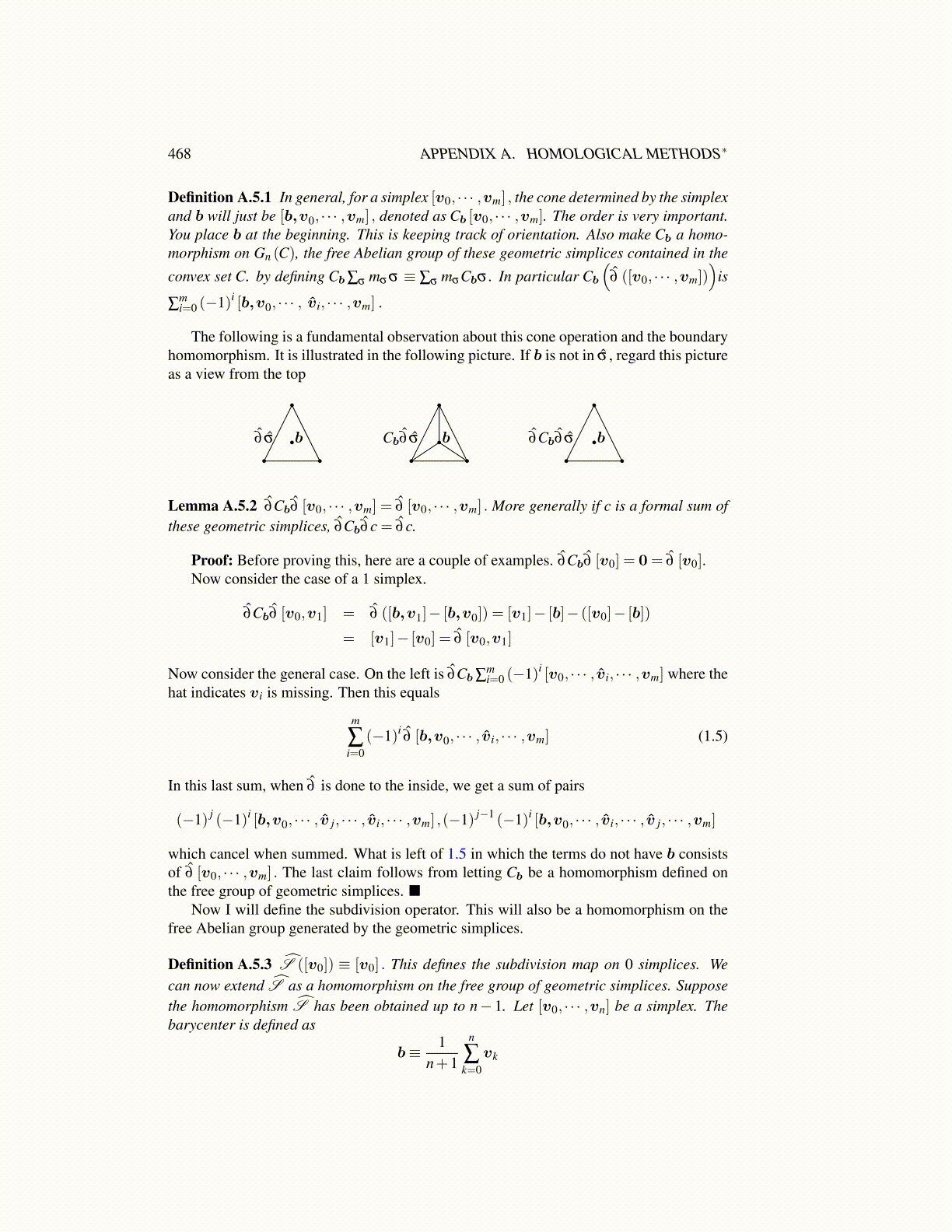
468 APPENDIX A. HOMOLOGICAL METHODS∗
Definition A.5.1 In general, for a simplex [v0, · · · ,vm] , the cone determined by the simplexand b will just be [b,v0, · · · ,vm] , denoted as Cb [v0, · · · ,vm]. The order is very important.You place b at the beginning. This is keeping track of orientation. Also make Cb a homo-morphism on Gn (C), the free Abelian group of these geometric simplices contained in the
convex set C. by defining Cb ∑σ mσ σ ≡ ∑σ mσCbσ . In particular Cb
(∂̂ ([v0, · · · ,vm])
)is
∑mi=0 (−1)i [b,v0, · · · , v̂i, · · · ,vm] .
The following is a fundamental observation about this cone operation and the boundaryhomomorphism. It is illustrated in the following picture. If b is not in σ̂ , regard this pictureas a view from the top
b∂̂ σ̂ bCb∂̂ σ̂ b∂̂Cb∂̂ σ̂
Lemma A.5.2 ∂̂Cb∂̂ [v0, · · · ,vm] = ∂̂ [v0, · · · ,vm] . More generally if c is a formal sum ofthese geometric simplices, ∂̂Cb∂̂c = ∂̂c.
Proof: Before proving this, here are a couple of examples. ∂̂Cb∂̂ [v0] = 0= ∂̂ [v0].Now consider the case of a 1 simplex.
∂̂Cb∂̂ [v0,v1] = ∂̂ ([b,v1]− [b,v0]) = [v1]− [b]− ([v0]− [b])
= [v1]− [v0] = ∂̂ [v0,v1]
Now consider the general case. On the left is ∂̂Cb ∑mi=0 (−1)i [v0, · · · , v̂i, · · · ,vm] where the
hat indicates vi is missing. Then this equals
m
∑i=0
(−1)i∂̂ [b,v0, · · · , v̂i, · · · ,vm] (1.5)
In this last sum, when ∂̂ is done to the inside, we get a sum of pairs
(−1) j (−1)i [b,v0, · · · , v̂ j, · · · , v̂i, · · · ,vm] ,(−1) j−1 (−1)i [b,v0, · · · , v̂i, · · · , v̂ j, · · · ,vm]
which cancel when summed. What is left of 1.5 in which the terms do not have b consistsof ∂̂ [v0, · · · ,vm] . The last claim follows from letting Cb be a homomorphism defined onthe free group of geometric simplices. ■
Now I will define the subdivision operator. This will also be a homomorphism on thefree Abelian group generated by the geometric simplices.
Definition A.5.3 Ŝ ([v0]) ≡ [v0] . This defines the subdivision map on 0 simplices. Wecan now extend Ŝ as a homomorphism on the free group of geometric simplices. Supposethe homomorphism Ŝ has been obtained up to n− 1. Let [v0, · · · ,vn] be a simplex. Thebarycenter is defined as
b≡ 1n+1
n
∑k=0
vk